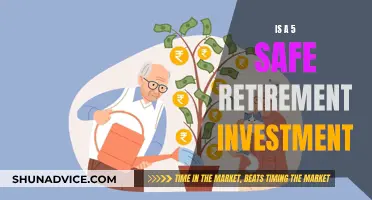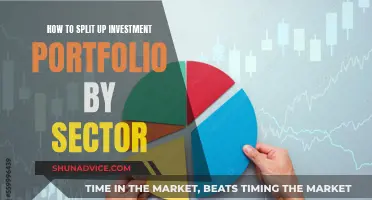
Speculative investments are high-risk positions in assets with frequent price fluctuations, providing both the opportunity for substantial gains and the risk of significant losses. They are characterised by the expectation of rapid value growth, often in the short term, and are typically made in markets such as foreign currencies, commodities, and cryptocurrencies. While speculative investments can lead to high returns, they also carry a substantial risk of loss and require active trading and a time commitment.
| Characteristics | Values |
|---|---|
| Risk of loss | High |
| Potential for gain | High |
| Focus | Short-term price movements |
| Asset type | Non-productive |
| Examples | Penny stocks, cryptocurrencies, precious metals, foreign currencies |
| Investor outlook | High-risk, high-reward |
| Investor experience | Experienced, knowledgeable |
| Time commitment | High |
| Active/passive | Active |
What You'll Learn
- Speculative investments are high-risk, short-term positions in assets with frequent price fluctuations
- Speculative investments differ from gambling as they involve analysis and take an asset's potential value into account
- Speculative trading is not just for professionals; however, it requires a certain level of knowledge and experience
- Speculative investments can be lucrative, but they come with risks and may not result in high returns
- Speculative investments are often considered non-productive assets, such as foreign and cryptocurrencies or commodities like gold and silver

Speculative investments are high-risk, short-term positions in assets with frequent price fluctuations
Speculative investments are high-risk financial transactions that focus on short-term profits from price fluctuations rather than long-term value growth. These investments carry a substantial risk of losing value but also offer the potential for significant gains. Speculators are typically more concerned with profiting from market value changes than with long-term investments.
Speculative investments are characterised by their high risk and relatively short time frames. They often involve assets with frequent price movements, such as foreign currencies, commodities, and stocks. For example, a speculator might invest in a foreign currency pair, such as EUR/USD, aiming to profit from changes in the value of one currency relative to the other.
Speculative investments differ from traditional investments, which focus on the core values of the investment. Speculators, on the other hand, seek to profit from short-term price movements, either upward or downward. They "speculate" on whether a price will increase or decrease and then buy or sell accordingly. This approach offers the potential for high profits but also carries the risk of significant losses.
Speculative investments are often associated with high-risk assets, such as cryptocurrencies, penny stocks, and junk bonds. These assets are known for their volatile nature and potential for substantial gains or losses. However, it is important to note that even traditional investments, such as real estate and stocks, can be considered speculative in certain cases.
While speculative investments offer the allure of quick profits, they also come with significant risks. They require a thorough understanding of market dynamics, effective risk management strategies, and the ability to handle volatile market conditions. Speculators need to carefully assess the risk versus reward of each investment opportunity and ensure they have the necessary knowledge and experience to navigate the complex world of speculative trading.
Protecting Your Managed Investments: Strategies for Success
You may want to see also

Speculative investments differ from gambling as they involve analysis and take an asset's potential value into account
Speculative investments involve calculated risks and expected returns despite uncertain outcomes. Speculators generally determine the risk versus reward ratio. They buy or sell assets, hoping for a bigger potential gain than the amount they risk. They know that the more risk they assume, the higher their potential gain. However, they also know they may lose more than their potential gain. For example, an investor may speculate that a market index will increase due to strong economic numbers and purchase futures contracts. If their analysis is correct, they can sell the contracts for a profit within a short to medium-term period. But if the market drops more than expected, they could lose more than anticipated.
Gambling, on the other hand, involves wagering money on an event with an uncertain outcome, hoping to win more money. It is a game of chance with a negative expected response. Gamblers understand that the odds of success are low, and the house usually wins. For example, in American roulette, a gambler bets on a single number, with a payout of 35 to 1, but the odds against winning are 38 to 1.
Speculative investments are characterised by high risk and relatively short time frames. For example, a trader may assume that the value of Bitcoin will keep rising against the dollar. They speculate on the price rise by going long on Bitcoin CFDs, focusing on a short-term price increase without considering long-term growth. Foreign currencies, hard commodities like precious metals, and cryptocurrencies are also considered speculative investments due to price fluctuations, high risk, and prospects for high returns.
While speculative investments and gambling both involve committing money to high-risk prospects, the expected results are very different. Speculative investments involve analysis and consideration of an asset's potential value, setting them apart from the chance-based nature of gambling.
PPF Investment Guide for NRIs: A Secure Option
You may want to see also

Speculative trading is not just for professionals; however, it requires a certain level of knowledge and experience
- Understanding the Nature of Speculative Trading: Speculative trading involves taking advantage of short-term price movements in the market. It is often characterised by buying and selling assets with the expectation of significant gains or losses in a short period. This type of trading is typically associated with high-risk investments and active trading strategies.
- Knowledge and Experience: While speculative trading is not exclusive to professionals, it does require a substantial level of knowledge and experience. Investors should familiarise themselves with market dynamics, technical analysis, and risk management techniques before engaging in speculative trading. Understanding market trends, analysing price patterns, and recognising potential risks are essential skills for anyone considering speculative trading.
- Risk Management: Speculative trading carries a high level of risk due to the unpredictable nature of price changes and market volatility. It is crucial for investors to understand and effectively manage these risks. This includes setting stop-loss orders, adjusting position sizes, and regularly monitoring trading performance metrics. A solid risk management strategy is essential to mitigate potential losses.
- Time Commitment: Speculative trading often demands a significant time investment. It requires active participation in the market and the ability to make quick decisions. Investors need to stay informed about market movements, news events, and other factors that can influence prices. Speculative trading may not be suitable for those who cannot dedicate the necessary time and attention.
- Emotional Discipline: Speculative trading can be emotionally challenging due to the potential for substantial gains or losses. Investors need to maintain discipline and avoid making impulsive decisions based on fear or greed. Emotional discipline helps traders stick to their strategies and avoid costly mistakes.
- Suitability for Different Investors: Speculative trading may not be suitable for all types of investors. It is crucial to assess your risk tolerance, investment goals, and financial situation before considering speculative trading. While it offers potential for high returns, it also carries a higher level of risk. Novice investors, in particular, should proceed with caution and ensure they fully understand the risks involved.
In conclusion, while speculative trading is not solely for professionals, it demands a strong foundation of knowledge and experience. Investors considering speculative trading should thoroughly educate themselves, develop a well-defined strategy, and maintain discipline in their approach. By doing so, they can improve their chances of success and maximise potential gains while effectively managing the inherent risks.
Understanding Investment Management Insurance: Protecting Your Financial Portfolio
You may want to see also

Speculative investments can be lucrative, but they come with risks and may not result in high returns
Speculative investments are high-risk positions in assets with frequent price fluctuations, providing both the opportunity for profit and the risk of loss. These investments aim for rapid value growth, often in the short term, and come with a high risk of substantial loss.
Speculative investors seek to profit from short-term upward or downward price movements. They "speculate" on whether a price will increase or decrease and then buy or sell accordingly. If they predict correctly, they make a profit; if not, they make a loss. This type of trading carries significant risk due to the unpredictable nature of price changes and market volatility.
Speculative investments differ from traditional investments, which focus on an investment's core values and are generally lower-risk and more passive. Speculative investments, on the other hand, are often short-term and involve alternative and niche assets such as art, foreign currencies, and cryptocurrencies.
Examples of speculative investments include penny stocks, cryptocurrencies, precious metals, and foreign currencies. These investments are typically susceptible to volatility, providing investors with the opportunity to profit from short-term price movements.
While speculative investments can provide significant returns, they also come with a high risk of loss. They require active trading and a time commitment and do not provide income while they are held. Additionally, there is a risk of losing one's entire investment.
Therefore, the choice to make speculative investments depends on an investor's risk tolerance, knowledge of the markets, and short- and long-term investment goals. Speculative investments may be lucrative for those with the necessary knowledge and experience, but they are not suitable for everyone.
Invest Wisely, Earn 6K Monthly: Strategies for Success
You may want to see also

Speculative investments are often considered non-productive assets, such as foreign and cryptocurrencies or commodities like gold and silver
Speculative investments are often considered non-productive assets, such as foreign currencies and cryptocurrencies, or commodities like gold and silver.
Non-productive assets are those that do not generate income or increase in value through their own productivity. Instead, their value typically comes from selling them at a higher price than they were purchased for.
Speculative investments are high-risk positions in assets with frequent price fluctuations, providing the opportunity for profit as well as the risk of loss. They are focused on short-term gains and are typically based on a "hunch" or speculation, rather than solid fundamentals.
Foreign currencies, for example, are a type of speculative investment where investors purchase and sell currency pairs such as EUR/USD. As the value of one currency drops, the other increases, and traders speculate on which way the relationship will go, hoping to profit from the change in value.
Cryptocurrencies are also considered speculative due to their price fluctuations, high risk, and prospects for high returns. The crypto markets are relatively young and unpredictable, making them a speculative investment.
Precious metals like gold and silver are another example of speculative investments. Their prices fluctuate based on factors including inflation, supply and demand, and changes in the value of other currencies.
While speculative investments carry a high level of risk, they also offer the potential for substantial gains. They can be a good way to diversify one's portfolio, particularly for active traders who can tolerate higher levels of volatility and risk.
How Much Should You Expect From Annual Investments?
You may want to see also







